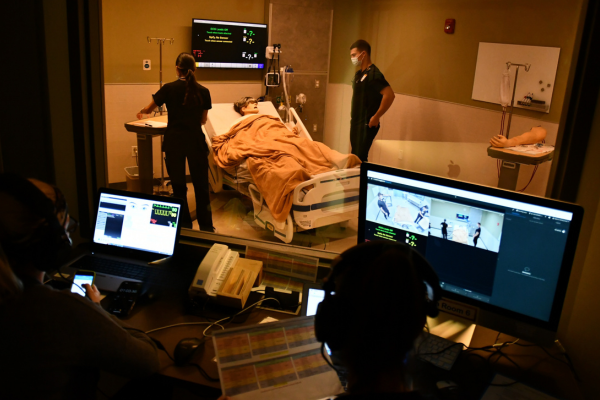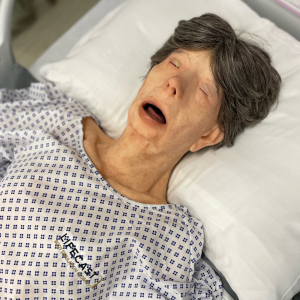Health Care Education Through Immersive Learning: A look inside the MU Sinclair School of Nursing Miller Family Simulation Center
The Miller Family Simulation Center is an immersive learning environment made up of a clinical skills lab and simulation suite with the goal of preparing students as much as possible for the transition to a clinical environment. Equipped with simulation technology, students practice nursing skills like CPR and tracheostomy care. This enhanced environment also develops critical thinking, psychomotor skills, bedside manner and team coordination, all crucial to becoming the Next Mizzou Nurse.
Clinical Skills Lab



The clinical skills lab (CSL) allows students to practice competencies in a “hospital” environment. The space is equipped with 14 beds, diverse patients, and everything expected in a traditional hospital setting, from dividing curtains and adjustable beds, to crash carts and supply stations. In addition, a conference style classroom in the center of the lab allows instructors to review curriculum with students and immediately put those skills into practice. The space can also be divided in two, allowing multiple classes to work in the lab at a time.
In the CSL, most of the patients are Laerdal manikins, equipped with computer driven physiological changes that allow students to practice a range of basic to advanced competencies. Expand the section below to learn more about our patients.
- Head with anatomical landmarks, trachea, and esophagus, along with simulated lungs and stomach, allow the practice of many procedures
- Application/instillation of medications in the eye, ear and nose, including nasal packing
- Insertion and suctioning of oropharyngeal and nasopharyngeal airways
- Insertion, securing, and care of endotracheal tubes
- Tracheostomy care and tracheal suctioning
- Various oxygen delivery procedures
- NG tube insertion, care, medication administration, and removal
- Gastric lavage and gavage
- Subclavian, jejunostomy and Hickman catheter openings
- Full range of motion and realistic patient weight and height for practice handling
- Interchangeable stomas depict colostomy, ileostomy and suprapubic cystotomy
- Colostomy may be irrigated and will retain an indwelling catheter
- Urinary catheterization
- Heart sounds synchronized with programmable ECG
- Auscultated lung sounds synchronized with breathing rate, 0 – 60 BPM
- Individual lung or bilateral sound selection
- Normal or abnormal bowel sounds
Hi-Fidelity Simulation Suite
Designed to replicate a seven bed ICU, students work with Hi-Fidelity Simulation including a nurses’ station, crash carts, medication room and interactive Laerdal and Gaumard manikins, which have electrocardiogram (ECG) and defibrillator capabilities. This expanded space offers Mizzou Nursing students advanced immersive learning paired with consistent high-level teaching and one-on-one instruction with faculty that will better train them to navigate critical patient scenarios and lead to life-saving care.



 SSON is also home to Mizzou’s only Lifecast manikin, Vivien. Vivien is a hyper-realistic geriatric manikin, with the weight and height of an average 82-year-old woman and exposes students to an ever-growing elderly population before entering clinical or practicum. She has complex skin features such as palpable veins, wrinkles, moles and age spots, as well as punched hair. Not only is she life-like in appearance, but her mobility is more realistic compared to other manikins, allowing students to practice moving and turning her with limbs that fold like an actual patient.
SSON is also home to Mizzou’s only Lifecast manikin, Vivien. Vivien is a hyper-realistic geriatric manikin, with the weight and height of an average 82-year-old woman and exposes students to an ever-growing elderly population before entering clinical or practicum. She has complex skin features such as palpable veins, wrinkles, moles and age spots, as well as punched hair. Not only is she life-like in appearance, but her mobility is more realistic compared to other manikins, allowing students to practice moving and turning her with limbs that fold like an actual patient.